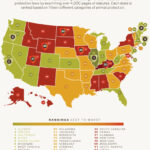Animal cruelty is a pervasive issue that plagues societies around the globe. Each year, countless animals suffer at the hands of individuals whose actions betray the trust of our most vulnerable companions. With growing awareness surrounding animal rights, it is crucial to delve into the statistical realm to understand the true scope of this problem. How many individuals are arrested for animal cruelty each year? This subtopic provides a window into the grim reality of animal abuse while also shedding light on the pressing need for reformative measures and societal change.
Understanding the statistics surrounding animal cruelty arrests can be a sobering endeavor. Official data, though not exhaustive, reveals that thousands of individuals are apprehended annually for acts of cruelty against animals. The figures can fluctuate significantly from year to year and are influenced by a myriad of factors, including changes in legislation, public awareness, and enforcement efforts. Often, the reported numbers reflect only a fraction of the actual occurrences, as many acts of cruelty go unreported or unrecognized by the legal system.
To create a clearer picture of the situation, one must explore the various forms of animal cruelty that garner arrests. These include physical abuse, neglect, hoarding, and exploitation. The physical abuse of animals can manifest in horrific ways, ranging from beatings to torture, often leaving lasting physical and psychological scars. Meanwhile, neglect—defined by the failure to provide adequate care, food, shelter, and medical attention—can be equally devastating, leading to malnourishment, disease, and even death.
Hoarding, an often misunderstood phenomenon, is classified by the accumulation of animals in unmanageable numbers. This condition frequently leads to unsanitary living conditions and insufficient care, culminating in distress for the animals involved. Lastly, exploitation encompasses a wide range of crimes, from dogfighting and illegal breeding operations to wildlife trafficking. Each of these categories not only contributes to the distress of countless animals but also highlights the need for stringent legal frameworks to combat such behaviors.
Demographic studies on arrests for animal cruelty reveal significant trends that warrant scrutiny. The statistics indicate that individuals arrested for animal cruelty tend to belong to various age groups and socio-economic backgrounds. While there is a notable prevalence among younger adults, the issue transcends age, suggesting that societal conditioning related to animal welfare is not confined to any particular demographic. Importantly, patterns in gender also emerge, as males are disproportionately represented among those arrested. These statistics advocate for comprehensive educational programs that target harmful behaviors and promote empathy towards animals across all demographics.
Another vital factor contributing to the numbers of individuals arrested is the legal framework governing animal cruelty. Each state has its own set of laws, which can significantly influence the rates of reported arrests. Some jurisdictions have enacted stringent anti-cruelty laws, yet in others, the legal repercussions remain lenient. This disparity in legislation results in varied arrest rates, hampering a comprehensive understanding of animal cruelty as a national issue. Efforts to standardize these laws could benefit not only the animals in peril but also those dedicated to enforcing justice.
Moreover, the role of grassroots advocacy organizations cannot be overstated in this discussion. These organizations work tirelessly on the front lines, promoting awareness, intensive training for law enforcement officials, and the establishment of programs designed to rehabilitate offenders. Their initiatives can lead to an increase in reports of animal cruelty, driving up the arrest rates. Coincidentally, they also emphasize the importance of community involvement in recognizing and reporting acts of cruelty. Such a paradigm shift in public perception is critical, as it encourages collective responsibility toward safeguarding animal welfare.
The role of social media has also revolutionized how animal cruelty is perceived and reported. Platforms designed for networking and sharing information serve as tools for activism, allowing individuals to document incidences of cruelty and mobilize their communities in a swift manner. The viral nature of these events can lead to immediate action by authorities, thereby leading to arrests that might otherwise never occur. This calls to attention the imperative need to facilitate constructive dialogue surrounding animal welfare in digital spaces.
While the increasing number of arrests may at first suggest a declining trend in animal cruelty, it’s crucial to approach these statistics with caution. The rise of arrests can represent an increased recognition of animal rights and a willingness among law enforcement agencies to take such matters seriously. Nevertheless, it may also signal that cases of severe cruelty are on the rise. Whichever perspective one adopts, it is evident that the complexities surrounding animal cruelty and its enforcement warrant ongoing examination.
Ultimately, the statistics reveal a haunting reality: animal cruelty remains an enduring issue that demands comprehensive societal solutions. One cannot address this heinous crime without looking beyond the figures to find the stories of the living beings affected. With resolute action, legislative reform, and increased public awareness, the cycle of cruelty can be broken. The need for compassion and empathy is paramount; society must cultivate a culture that vehemently opposes cruelty in all forms. In doing so, a safer, more humane world for all creatures can be envisioned.







